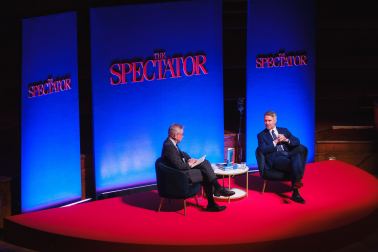The situation in Dublin yesterday – in which five people were injured in a knife attack in the heart of the city, resulting in a riot and violent clashes with the police – was to the untrained eye reminiscent of Belfast from days gone by.
Speculation about the nationality of the attacker fuelled the scenes of violence which took place last night and that has led to condemnatory tutting. After all, Ireland’s national myth is tied into tales of immigration and welcoming. A riot over immigration in its capital city contradicts the stories Ireland tells the world about itself.
The instinct, almost reflex reaction of the establishment, was to deploy the term ‘far right’. The commissioner of the Garda, Drew Harris, said that a ‘hooligan faction driven by a far-right ideology’ were to blame.
There’s no doubt that far-right elements were involved in the violence. But it is too easy for a society and a governing class, frantically obsessed with positioning itself as a good global citizen, to blame this unseemliness on a fringe. This is not the Dublin of Guinness and glass palaces housing tech companies which it wishes to present to the world.
To immediately sound the far-right klaxon betrays an institutional glibness which explains many of the inherent, simmering tensions currently characterising Irish political debate.
This, after all, was not the first act of random street violence in Ireland in recent times. There was a stabbing at Dublin Airport in September, while a woman was stabbed in the centre of Dublin on Chatham Street on Thursday night last week.
Concerns about the impact of immigration and Ireland’s readiness to cope with it is starting to ratchet up. These tensions are undoubtedly intertwined with the Republic’s unprecedented housing crisis. There has been a record amount of homeless in recent years. People’s anecdotes about rental prices in Dublin would make even a hardened Londoner blanche. No wonder Ireland has seen protests when migrants are moved into accommodation ahead of Irish people who have been waiting for a home for some time.
What is Ireland’s escape route from this quagmire? A great many – based on current polling – want to chuck their lot in with Sinn Fein, such is the contempt for the Fine Gael and Fianna Fail cabal which has taken turns at running the country. That such a party is being viewed as a solution says a great deal about the mire the Republic finds itself in.
A poll by the Business Post found that 75 per cent of people believed that Ireland is taking in too many refugees. Interestingly, 83 per cent of Sinn Fein supporters endorsed this view, with between 70 to 74 per cent of the supporters of the two other main parties also agreeing with that statement.
To therefore immediately blame unrest on the far right, as the Irish government and police have done, shows yet another European establishment out of kilter with its people on immigration.
Undoubtedly there was clear desire for opportunistic violence amongst some of the crowd who rioted last night. However, the crux of the matter will be the stabbing which led to those riots, and the circumstances which allowed such an attack to take place.
In the court of public opinion, particularly in Brussels, the Republic and its leaders have for many years wanted to be patted on the head for ‘doing the right thing’. They have wanted to be the friendly country – and certainly friendlier than the English across the water. However, as the old political elites in Sweden and the Netherlands are now finding, there is a price to pay for such a lax approach to the questions of immigration and integration. Will the Irish political establishment cotton on before it is too late for them? Based on their response in the past 24 hours, I wouldn’t bet on it.
This article is free to read
To unlock more articles, subscribe to get 3 months of unlimited access for just $5







Comments
Join the debate for just £1 a month
Be part of the conversation with other Spectator readers by getting your first three months for £3.
UNLOCK ACCESS Just £1 a monthAlready a subscriber? Log in